![]()
Wed, Nov 17, 2010 | Our Ararat | By Crethi Plethi
Poster Art of the Armenian Genocide
Recently [Sept 05, 2010] we reported about Hamid Baqa’i, one of Ahmadinejad’s vice presidents and chief of the Cultural Heritage and Tourism Organization, who spoke at a conference titled “Iran—Bridge to Victory” (August, Tehran), where he said that in 1915 the Ottoman Empire had committed a “massacre” against the Armenians people. His remarks sparked a diplomatic incident between Iran and Turkey. The Turkish government is very quickly annoyed when it comes to the Armenian Genocide.
But the remarks made by Hamid Baqa’i also suggested that there is a lively debate going on in Iran’s governmental and intellectual circles on the Armenian Genocide in relation to the Iranian-Turkish ties. However, this is not the case. The truth is that the Armenian Genocide has been little discussed among the general population of Iran.
By the end of the nineteenth century, there were some 300,000 Armenians in Iran (Persia at the time) representing almost 3% of the Iranian population of 1900. The massacres at the end of 19th century and early 20th century brought more Armenian refugees to north-western Iran. Thousands of Armenians escaped to Iran during the Armenian genocide. During the 19th and 20th centuries, the Iranian-Armenians were very active in the modernization of Iran, but the Islamic Revolution (1979) signaled the end of the “golden age” of the Armenian community in Iran.
Recent estimates put the numbers of Iranian-Armenians still living in Iran between 40,000-80,000 due to emigration to Western democracies and the USA. They are still the largest Christian religious minority in Iran.
But the Iranian-Armenian community in Iran is nevertheless active in keeping the remembrance of the Armenian Genocide alive. From June 21-28, the Armenian Prelacy of Tehran and the Commemoration Committee of the 95th Anniversary of the Armenian Genocide organized two lectures by Prof. Taner Akcam[1] dedicated to the launching of the Farsi translation of his book “A Shameful Act: The Armenian Genocide and the Question of Turkish Responsibility.” Other speakers were Robert Beglatian, the parliamentary representative of Armenians in the southern regions of Iran and Dr. Ayda Hovhanissian from the Armenian Prelacy of Tehran. Iranian Parliamentary members, university professors, students, researchers, authors, Armenian community representatives, and a public of more than 300 attended the event. [The Armenian Weekly, Tue, July 06, 2010].
On the 9th of September, 2004, Iranian President Seyed Mohammad Khatami, in the second day of his official visit to Armenia, visited the Memorial Complex Tsitsernakaberd in Yerevan and laid a wreath on the Memorial for the Victims of the Armenian Genocide in Ottoman Turkey in 1915. Armenia’s chief of presidential staff Artashes Tumanian, Yerevan mayor Yervand Zakharian, Armenian deputy foreign minister Ruben Shugarian, and other high-ranking officials accompanied Khatami.
The director of the Genocide Museum at Tsitsernakaberd, Lavrenti Barseghian, briefed the Iranian president on the history of the museum.
Talking to journalists, Lavrentiy Barseghyan said that the Iranian leader has become the forth Moslem leader to visit Tsitsernakaberd after the presidents of Tajikistan, Kyrgyzstan and Lebanon. He expressed hope for recognition of the Armenian Genocide by Iran in the nearest future. Until now, Iran has not done so. Only the Lebanese parliament recognized the Armenian Genocide [on March 11, 2000] in full agreement and in this case condemned the Turkish government; in the course of it, it asked parliament of all the countries to join Lebanon in this case.
Here are interesting poster art about the Armenian Genocide which are worth showing, from the project ArmenianGenocidePosters.org:
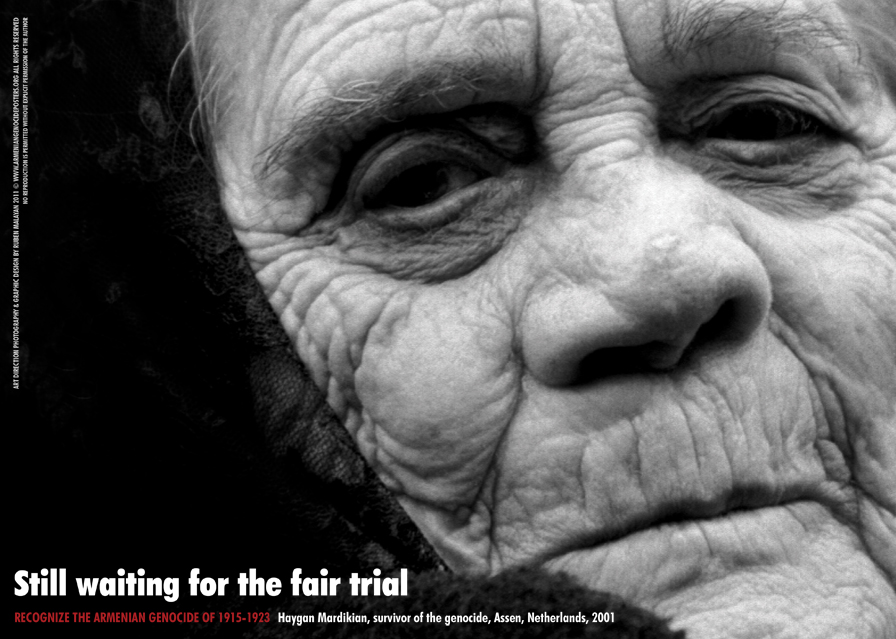
"Still waiting for the fair trial" - Design & Photography by Ruben Malayan (www.armeniangenocideposters.org - this project is an initiative of 15levels.com)
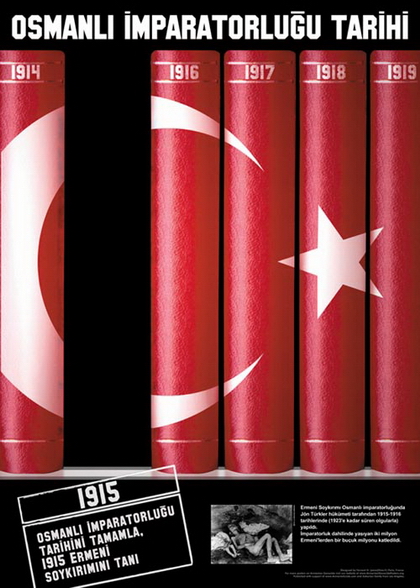
"Ottoman History" - Design by Yervant Herian (www.armeniangenocideposters.org - this project is an initiative of 15levels.com)

English version of "Ottoman History" - Design by Yervant Herian (www.armeniangenocideposters.org - this project is an initiative of 15levels.com)
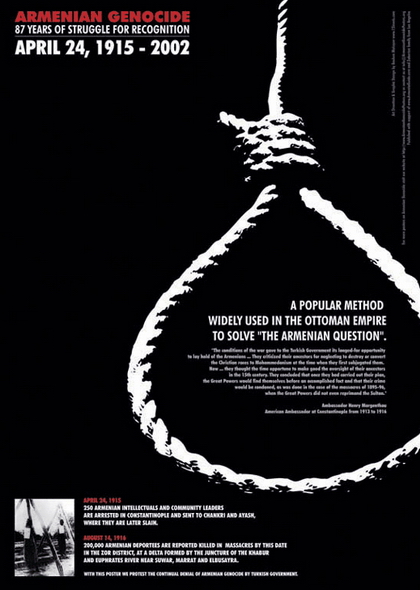
"Popular Method" - Design by Ruben Malayan (www.armeniangenocideposters.org - this project is an initiative of 15levels.com)
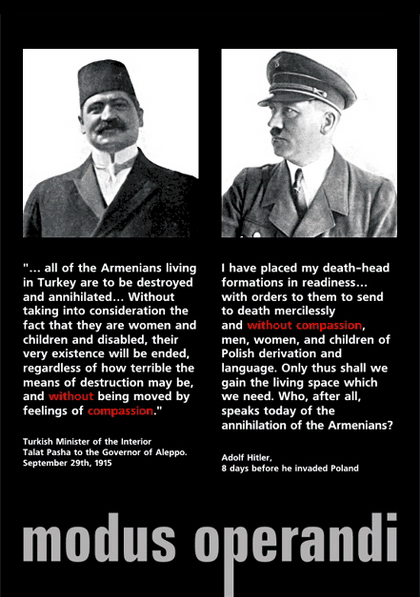
"Modus Operandi" - Design by Karen Vrtanesyan (www.armeniangenocideposters.org - this project is an initiative of 15levels.com)
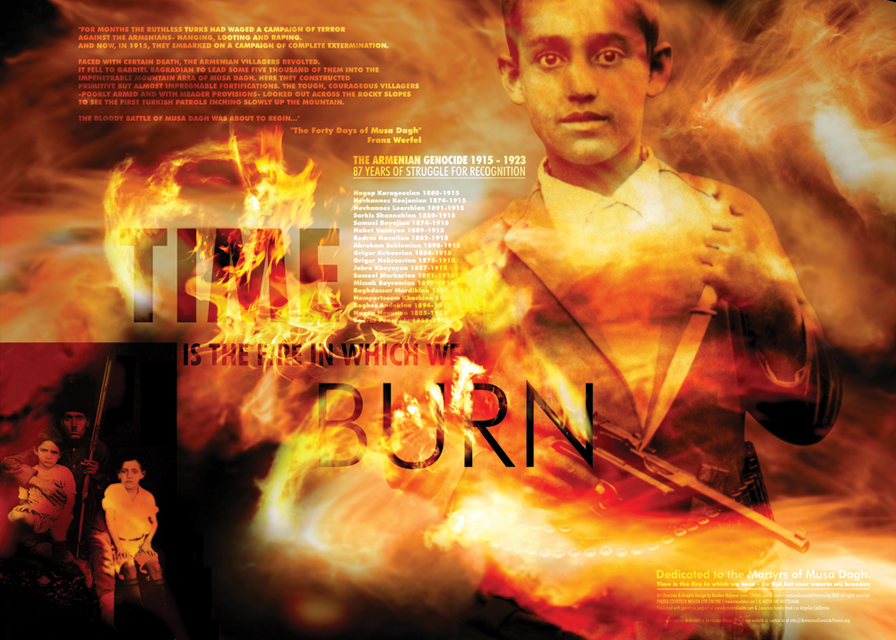
"Time is the fire in which we burn" - Design by Ruben Malayan (www.armeniangenocideposters.org - this project is an initiative of 15levels.com)

"90 years, still alive" - Design by Maria Victoria Mustillo (www.armeniangenocideposters.org - this project is an initiative of 15levels.com)
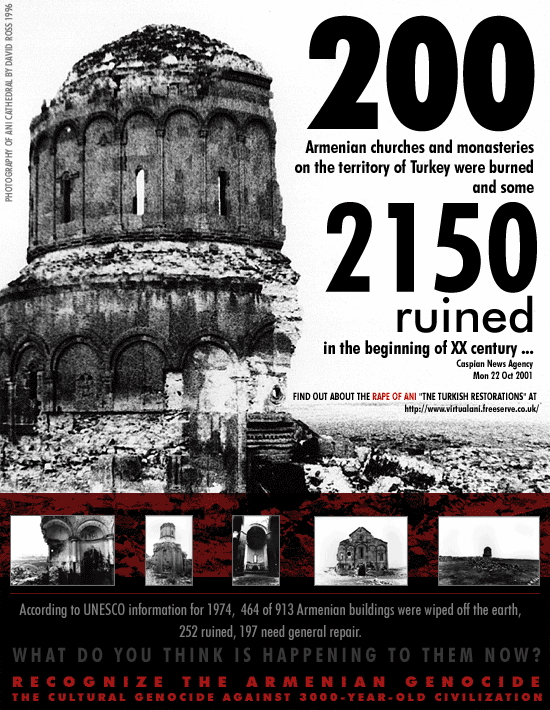
"Cultural Genocide" - Design by Ruben Malayan (www.armeniangenocideposters.org - this project is an initiative of 15levels.com)
The Mount Ararat, where the bible says Noah’s ark came to rest after the flood, is the national icon of Armenians. But today this national icon isn’t in Armenia. It is in what used to be Western-Armenia, but after the Turkish-Persian wars of 1602-1639 Western Armenia became part of the Ottoman Empire. It was especially in these regions that the Armenian Genocide took place and it is still occupied by the Turks until this day. [2]
Note:
[1] Taner Akcam is the Robert Aram and Marianne Kaloosdian and Stephen and Marion Mugar Chair in Modern Armenian History and Genocide Studies at Clark University.
[2] Western-Armenia.



 RSS
RSS


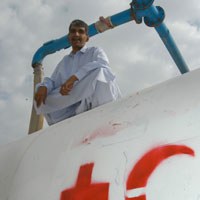

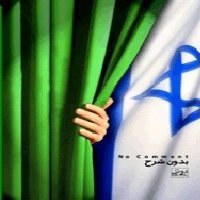





#Poster #Art of the #Armenian #Genocide | #Iran #Turkey http://j.mp/cYqXPb
RT @CrethiPlethi: #Poster #Art of the #Armenian #Genocide | #Iran #Turkey http://j.mp/cYqXPb
RT @RantsbyRemnant: RT @CrethiPlethi: #Poster #Art of the #Armenian #Genocide | #Iran #Turkey http://j.mp/cYqXPb
RT @CrethiPlethi: #Poster #Art of the #Armenian #Genocide | #Iran #Turkey http://j.mp/cYqXPb